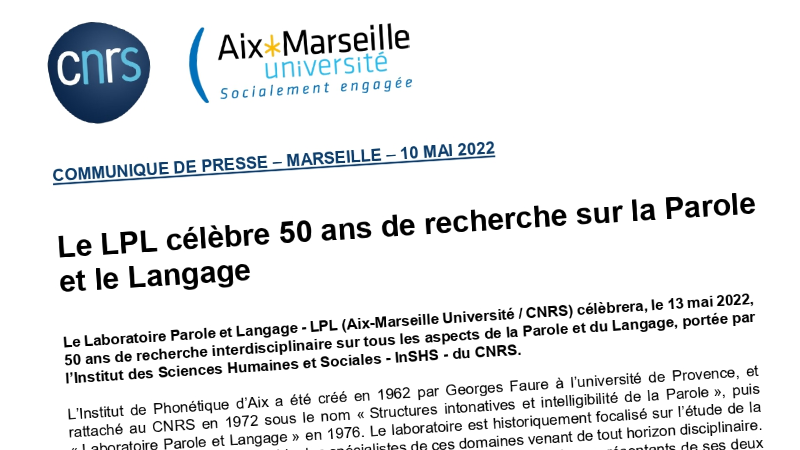
The Laboratoire Parole et Langage - LPL (Aix-Marseille Université / CNRS) will celebrate, on May 13, 2022, 50 years of interdisciplinary research on all aspects of Speech and Language, supported by the Institute of Human and Social Sciences - InSHS - of the CNRS.
The Institut de Phonétique d'Aix was created in 1962 by Georges Faure at the University of Provence, and attached to the CNRS in 1972 under the name "Structures intonatives et intelligibilité de la Parole", then "Laboratoire Parole et Langage" in 1976. The laboratory is historically focused on the study of speech and language and brings together specialists in these fields from all disciplinary backgrounds.
On May 13, the fiftieth anniversary of this laboratory will be celebrated in the presence of representatives of its two supervisory bodies - CNRS and Aix-Marseille Université. The history of the laboratory and its particular place in the scientific and technological community will be developed: a pioneer laboratory in the field of prosody analysis, an innovative laboratory in the design and realization of scientific instrumentation to measure speech, an interdisciplinary laboratory in its openness to life sciences and engineering sciences. The work of doctoral students, the experimental platform and the research teams will also be highlighted during this day.
The original identity of the laboratory, focused first on prosody and experimental phonetics, has allowed it to be throughout its history a thematic laboratory going beyond disciplinary constraints, focused on its objects of study: speech and language.
- As the cradle of the study of speech prosody (its rhythm, melody, and accentuation), the laboratory remains an internationally recognized center in this field, producing numerous publications addressing prosody in all its aspects and functions: as a vector of linguistic meaning articulated with lexical and syntactic domains, as an organizing element of our conversations, and as a bearer of extra-linguistic information (notably emotions).
- Since the creation of this "humanities" laboratory, experimental phonetics has allowed it to be naturally predisposed to a profound interaction with the life sciences (since speech is produced and perceived by human organs) and the engineering sciences (since the analysis of speech, a fleeting phenomenon, requires signal recording and analysis techniques).
- This open position has allowed the LPL to be at the forefront of studies on multi-modality (or how the study of speech in context cannot do without the study of gestures and facial expressions), but also at the heart of the development of the interface with cognitive sciences.
The LPL addresses speech and language in all their aspects: the mechanisms of speech production (from articulatory physiology to neurophysiology), speech perception and language comprehension, the underlying cognitive representations and temporal dynamics of these production and perception processes, as well as the linguistic systems required to use this physical material (acoustic and visual) to communicate and interact.
In order to answer these questions, the laboratory has constantly nurtured a culture of scientific instrumentation: from its conception to its realization. In particular, the laboratory has developed the prosodimeter (acquisition and analysis of the tonal melody and intensity of the voice) or the polyphonometer (which measures airflow during speech activity), ancestor of the EVA (Assisted Voice Evaluation) station, an important research tool, especially in relation to clinical applications.
The experimental activity and the empirical anchoring linked to the production of data sets have always been accompanied by an experimental platform which has become the "Centre d'Expérimentation sur la Parole" and which has been labelled "Plateforme Technologique". The platform allows the video and audio capture of speech activity in the best conditions (anechoic chamber), offers instruments measuring behavioral (oculometry, response time), articulatory and aerophonological activity, but also physiological and neuro-physiological.
Thus, the laboratory is actively developing openings and collaborations with colleagues in the world of health, education, and digital applications . These three domains are perfect examples of a virtuous circle between fundamental research and application. The specific variation situations and contexts related to these domains provide relevant paradigms for asking fundamental questions about language. In turn, the results of the laboratory's research can be formulated and applied in these practical contexts.
Finally, the interdisciplinary positioning has allowed the laboratory to be a major actor in the structuring of the Aix-Marseille site for research on Language, Communication and the Brain through the creation of the LABEX "Brain and Language Research Institute" (in 2012) further developed in the framework of the Convergences Institutes with the "Institute of Language, Communication and the Brain" (in 2016) which federates the work of a dozen laboratories from various disciplines (Linguistics, Psycholinguistics, Neurolinguistics, Computer Science, Mathematics, Acoustics) on the site.
About LPL
-
The website: https: //www.lpl-aix.fr
-
The laboratory's highlights: https: //www.lpl-50ans.fr/histoire/
-
The institutional event of May 13 : https://www.lpl-50ans.fr/celebration-officielle-des-50-ans-du-lpl/
Laboratoire Parole et Langage
- Laurent Prévot I Director I laurent.prevot[at]univ-amu.fr
- Claudia Pichon-Starke I Communications Manager I claudia.pichon-starke[at]univ-amu.fr
CNRS Provence and Corsica
- Karine Baligand | Head of the Communication Department | karine.baligand[at]cnrs.fr
Aix-Marseille Université
- Clara Bufi I Director of Communications I clara.bufi[at]univ-amu.fr

